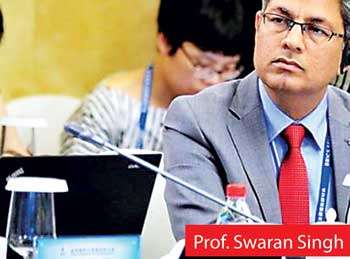Reply To:
Name - Reply Comment
Last Updated : 2024-04-19 00:03:00
 Despite striking similarities in culture and a shared history going back to ancient times, South Asia is one of the least integrated regions in the world. But there are visible signs of change both within South Asia and in the way the world looks at the region, avers Dr. Swaran Singh, Professor at the Center for International Politics, Organization and Disarmament, Jawaharlal Nehru University, New Delhi.
Despite striking similarities in culture and a shared history going back to ancient times, South Asia is one of the least integrated regions in the world. But there are visible signs of change both within South Asia and in the way the world looks at the region, avers Dr. Swaran Singh, Professor at the Center for International Politics, Organization and Disarmament, Jawaharlal Nehru University, New Delhi.
 Currently a Senior Fellow at the Institute of National Security Studies Sri Lanka (NSSSL), Dr. Singh says that there is an increasing realisation, both among the constituent countries of the region and the world powers, that South Asia has to be seen as a whole in strategic, economic and developmental terms.
Currently a Senior Fellow at the Institute of National Security Studies Sri Lanka (NSSSL), Dr. Singh says that there is an increasing realisation, both among the constituent countries of the region and the world powers, that South Asia has to be seen as a whole in strategic, economic and developmental terms.
Changes
“Anyone looking at South Asia as a whole, will notice two things: Firstly, there is visible prosperity. India, which is the biggest country in the region, is now among countries with the fastest rate of growth. Secondly, all countries in the region are now democratic. Earlier, South Asian countries, barring India and Sri Lanka, had been under military rule periodically (like Pakistan and Bangladesh) or under a monarchy (Bhutan and Nepal).”
“And thanks to growing prosperity and democratization, South Asia is now witnessing greater empowerment of its peoples, though many issues and challenges are yet to be solved or met adequately, ” Dr.Singh said.
The economic, political and social changes brought about by empowerment have created a vast market for goods and services, making South Asia a region attractive for outsiders with wares to sell, services to provide and money to invest.
Inter-Connectivity
 The demand for trade necessitates inter-connectivity. Therefore, inter-connectivity is the buzzword now with many international structures being set up to work on it, such as the Bay of Bengal Initiative for Multi-Sectoral Economic and Technical Cooperation (BIMSTEC).
The demand for trade necessitates inter-connectivity. Therefore, inter-connectivity is the buzzword now with many international structures being set up to work on it, such as the Bay of Bengal Initiative for Multi-Sectoral Economic and Technical Cooperation (BIMSTEC).
The region is also being considered relatively safe for investment. “The fear of an India-Pakistan showdown ending up in a nuclear war in the subcontinent has all, but disappeared. In fact, the focus is no longer on the India-Pakistan conflict, but on the increasing competition between India and China in the economic and strategic spheres,” Dr.Singh pointed out.
Turning away from the India-Pakistan conflict, the Western world is now envisaging a role for Pakistan in the peace process in Afghanistan. Given the already existing Indian outreach in Afghanistan and China’s growing interest in that country, China now wants India to jointly execute development projects there.
Terrorism
Bur there is one nightmarish problem facing South Asia, and that is the scourge of terrorism, both domestic and cross-border. Therefore, in contrast to the past, the focus now is on terrorism and cross-border terrorism.
“Afghanistan and Pakistan are seen as breeding grounds of terrorism,” Dr.Singh noted.
In 2010, the US had imposed sanctions on the financial and support networks of Pakistan-based Lashkar-e Taiba (LeT) and Jaish-e Mohammed (JeM). The UN Security Council has been wanting to declare the JeM leader, Masood Azhar, as a “global terrorist” but China has been putting a spoke in the wheel to help out its “all-weather friend” Pakistan. Beijing’s plea is that the demand for the ban does not follow the UNSC’s requirements.
The LeT, with links to Osama bin Laden and the Al-Qaeda network, had already been designated as a “foreign terrorist organization” in December 2001.
“Terrorism is a big issue in the world today. But the South Asian Association for Regional Cooperation (SAARC) had foreseen it way back in 1987 when it signed a Regional Convention on the Suppression of Terrorism. Taking the lead, India had proposed a UN Convention on the Suppression of Terrorism in 1996,” Prof. Singh recalled.
But deeply concerned about the lack of progress in suppressing terrorism, India’s Prime Minister Narendra Modi has been giving top priority to the subject in his dealings with other countries. He has told Pakistan in no uncertain terms that terrorism and talks cannot go together. This was reiterated when the present Pakistani Prime Minister, Imran Khan, made an offer to hold talks with India on all outstanding issues, Dr. Singh pointed out.
Asked if the conflict with Pakistan on the issue of cross border terrorism is not hampering cooperation through an established institution like SAARC, Dr. Singh said that India is circumventing this problem by building other networks where Pakistan is not involved, such as BIMSTEC.
“After the BRICS (Brazil, Russia, India, China, South Africa) summit in Goa in 2016, Prime Minister Modi organized a BRICS-BIMSTEC outreach summit there. At that summit attended by Bangladesh, India, Myanmar, Thailand, Bhutan, Nepal and Sri Lanka, combating terrorism was given high importance, though BIMSTC had nothing to do with terrorism per se.
The first BIMSTEC military exercise was held in Pune in September 2018.All member countries barring Nepal and Thailand, sent their teams. Apparently, China had dissuaded Nepal from participating, Dr. Singh said.
China’s entry
As an expert on China, Dr. Singh said that China’s entry into South Asia is a major new factor. In his view, China’s engagement with the region is “continuous, enormous and influential.”
He pointed out that out of the six major projects in China’s Belt and Road Initiative (BRI), four are in South Asia. China is also present in the Bangladesh, China, India, Myanmar Forum (BCIM). However, to date, China’s flagship project in the region is the China Pakistan Economic Corridor (CPEC). China has ports in Sri Lanka and Pakistan and is planning one in Myanmar. A China-India-Nepal-Corridor on the anvil. “Through these corridors, China will have a 1.5 billion strong market,” Dr. Singh pointed out.
Checkbook Diplomacy
It was during the 1997 world financial crisis, that China came up with the idea of extending its economic and strategic influence overseas through “checkbook” diplomacy, Dr. Singh said. “ When the US dithered at that time, China became pro-active.”
According to Dr. Singh, China’s interests are at once economic and strategic. China’s strategy is to try and get recipient countries into a debt trap so that they will, over time, surrender their assets in lieu of repaying loans, he said.
Dr.Singh questioned the veracity of China’s claim that a good part of its loans is given at a very low rate of interest and some of the money is given as a grant. The initial jacking up of the cost of the project nullifies the effect of giving a part of the loan at a low rate of interest. And under the counter payments to influential local parties facilitate the acceptance of such deals, Dr. Singh observed.
“Extraction and usurpation are the twin aims of the BRI,” he added.
Sovereignty
India’s opposition to the China-funded CPEC in Pakistan is based on the ground that a part of the corridor passes through a part of Kashmir which India considers its legal entitlement.
The Indian scholar said that China has no right to point an accusing finger at India in this regard as China had successfully prevented the Asian Development Bank from investing in the Indian State of Arunachal Pradesh arguing that this State is part its Tibet Autonomous Region.
“I tell the Chinese: Apply your own principle to India’s objection to CPEC, then you will appreciate New Delhi’s stand,” Dr. Singh said.
Explaining India’s objection to China’s ring of ports around it Dr. Singh said that India feels vulnerable because these ports have a dual purpose. However, China’s main aim is not to intimidate India as such but to checkmate the United States.
Objection Restricted TO CPEC
However, India’s objection to BRI is restricted to CPEC, Dr. Singh said. India’s attitude towards BRI softened when Chinese President Xi Jinping proposed that India is welcome to take up joint projects with China in third countries. There is already a proposal for India and China to jointly engage in development projects in war torn Afghanistan.
Therefore, in the midst of conflicts, India and China are exploring spaces for cooperation. There is already cooperation between the Indian and Chinese navies in anti-piracy operations in the Gulf of Aden and off the Somalian coast, Dr.Singh pointed out.

Add comment
Comments will be edited (grammar, spelling and slang) and authorized at the discretion of Daily Mirror online. The website also has the right not to publish selected comments.
Reply To:
Name - Reply Comment
On March 26, a couple arriving from Thailand was arrested with 88 live animal
According to villagers from Naula-Moragolla out of 105 families 80 can afford
Is the situation in Sri Lanka so grim that locals harbour hope that they coul
A recent post on social media revealed that three purple-faced langurs near t